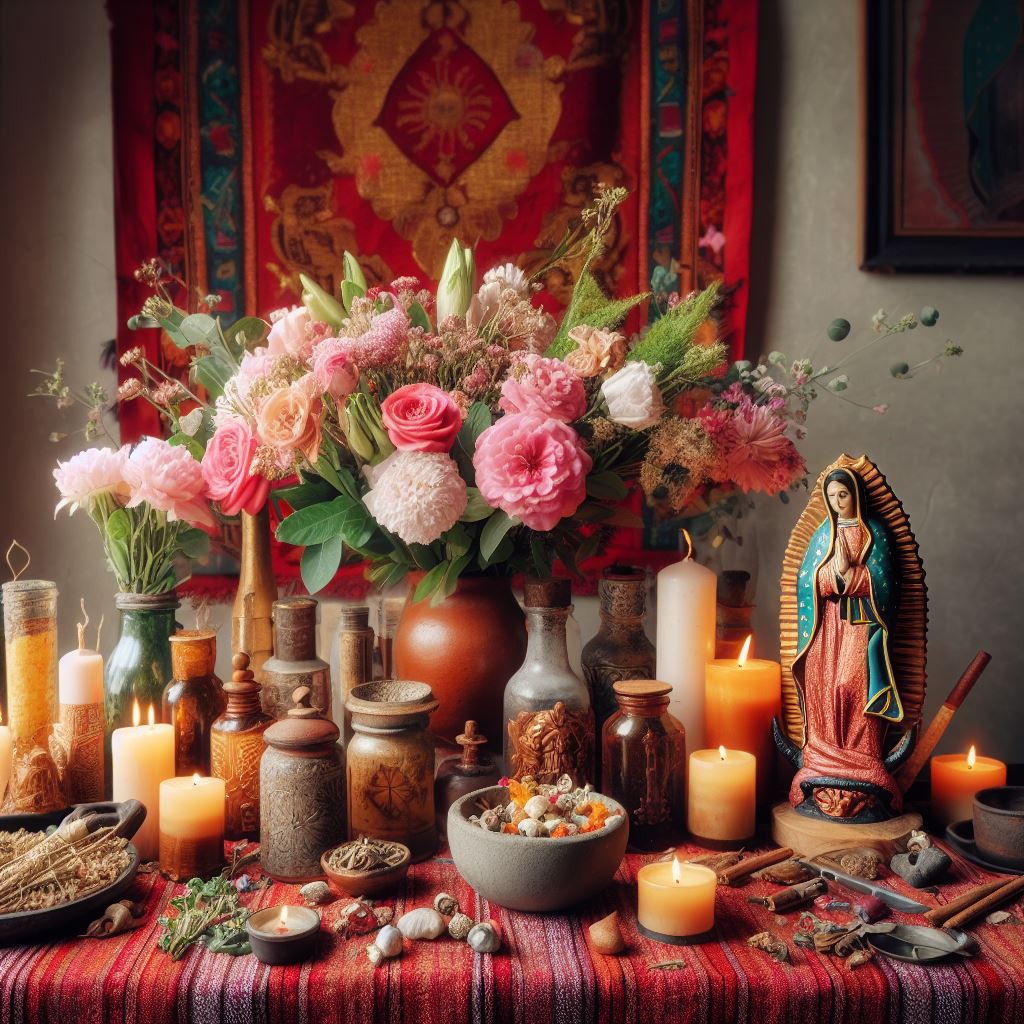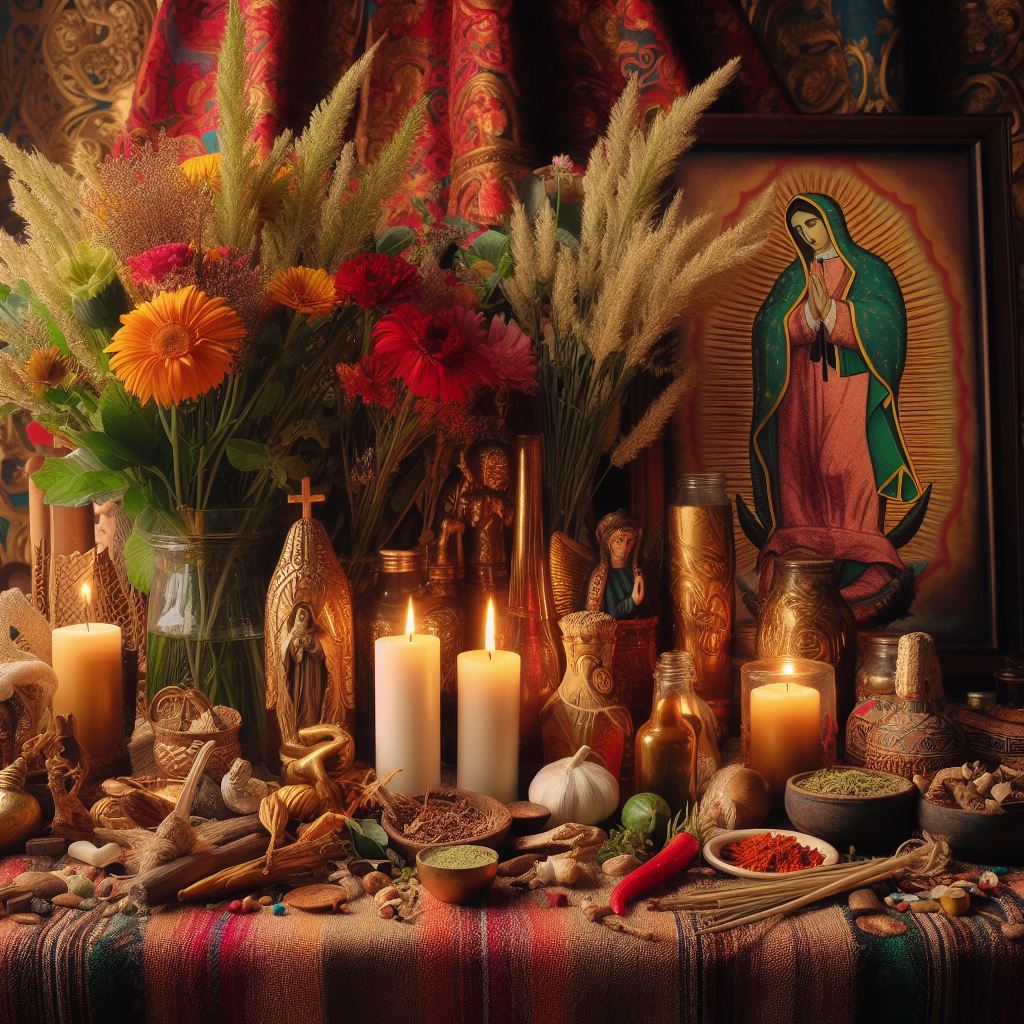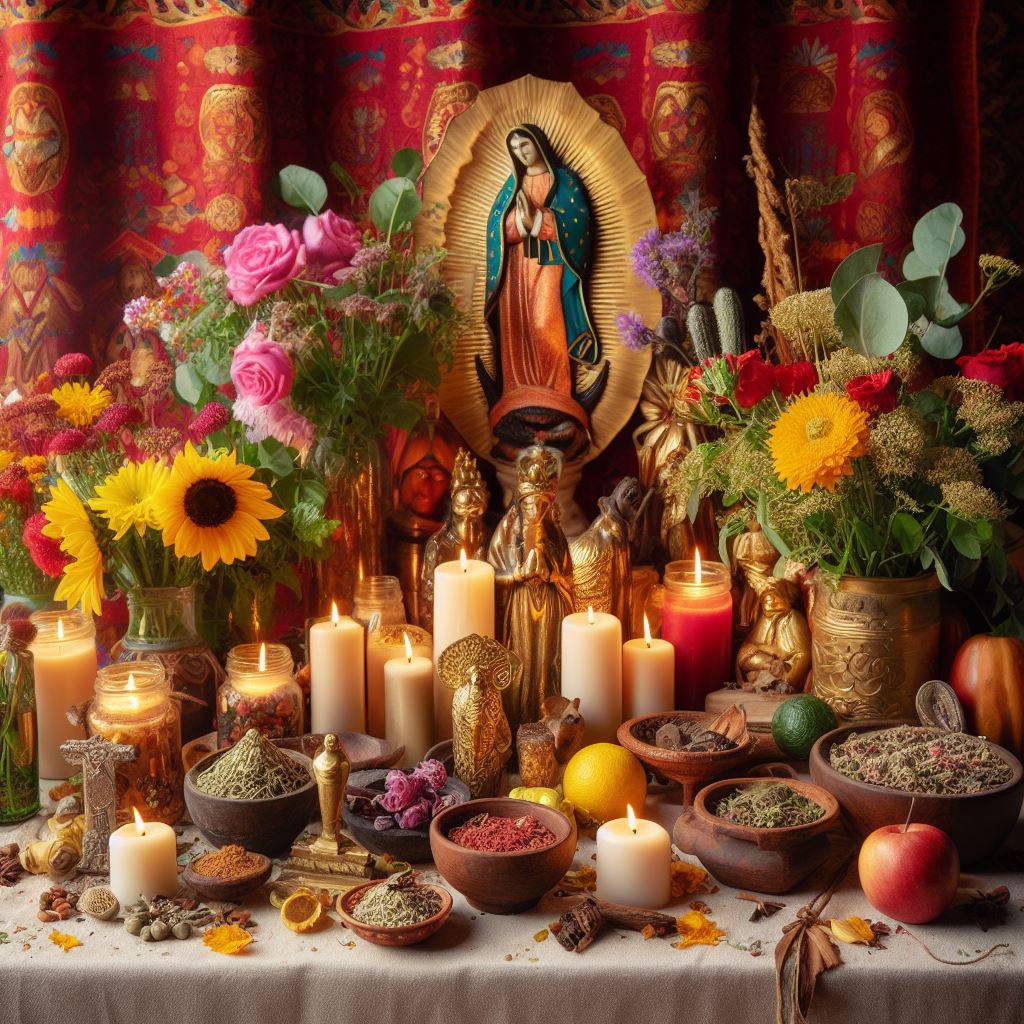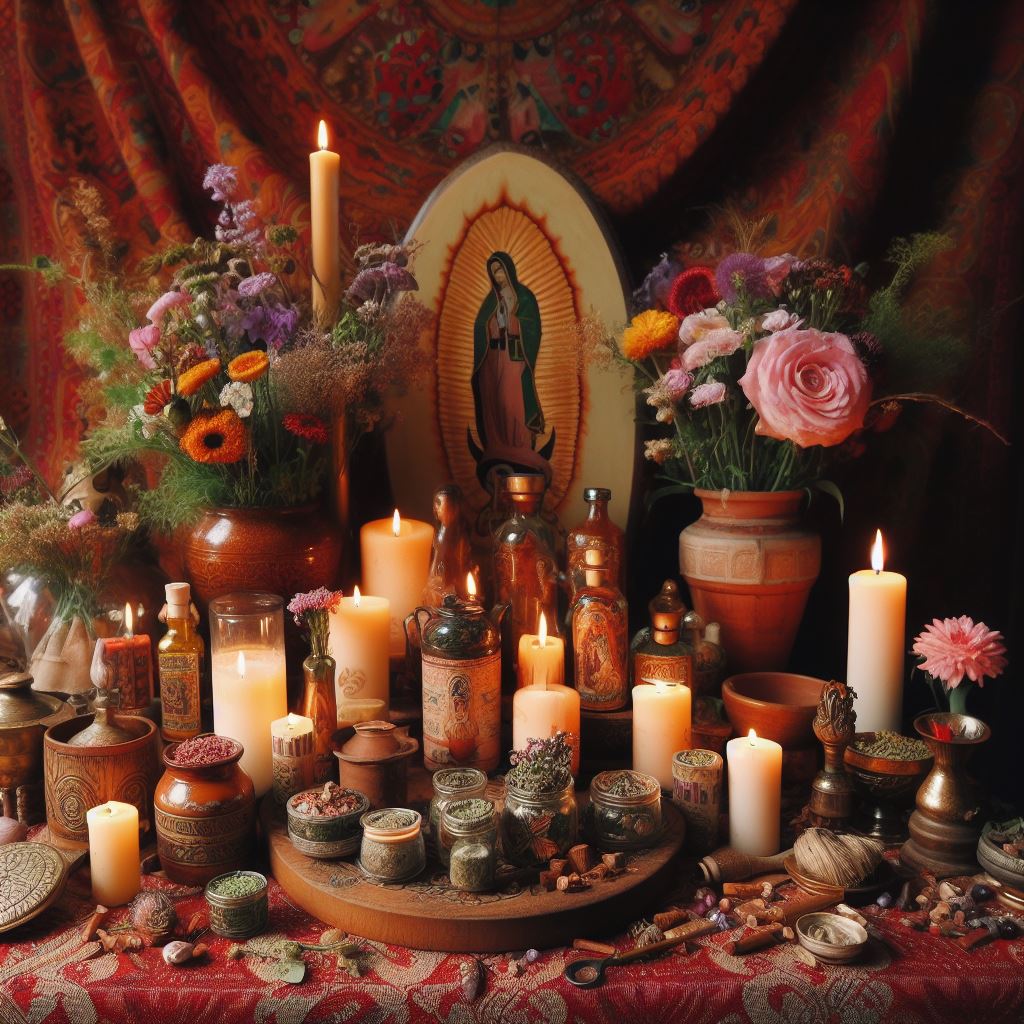The Rich Tapestry of Mexico’s Botanica
In Mexico, the concept of a “Mexico Botanica” encompasses much more than just a place to buy herbs and remedies. It represents a deep-rooted connection to nature and a profound understanding of the healing properties that plants possess. These botanical shops are not only a source of medicinal plants, but also a hub of knowledge where ancient wisdom is passed down through generations.
Walking through the bustling streets of Mexico City, one can stumble upon a Botanica tucked away in a corner, its vibrant storefront adorned with colorful flowers, herbs, and mystical artifacts. Stepping inside, the air is filled with the intoxicating aroma of dried herbs and incense, creating an atmosphere that is both soothing and invigorating.
The shelves are lined with jars filled with dried leaves, roots, and flowers, each carefully labeled with their traditional uses and properties. From chamomile for relaxation to sage for purification, these botanical treasures hold the secrets to a myriad of ailments and spiritual needs. The shopkeepers, often knowledgeable curanderos or healers themselves, are always ready to offer guidance and advice, ensuring that each customer finds the perfect remedy for their specific needs.
Thank you for reading this post, don't forget to subscribe!

But a Botanica is not just a place to purchase herbs; it is a sanctuary where ancient traditions come alive. The walls are adorned with intricate paintings and sculptures depicting deities and spirits, representing the fusion of indigenous beliefs and Catholicism that is deeply ingrained in Mexican culture. These artistic expressions serve as a reminder of the profound spiritual connection that exists between humans and the natural world.
In addition to the physical offerings, a Botanica is a place of spiritual guidance and divination. Many offer services such as tarot readings, energy cleansings, and spiritual consultations. These practices, rooted in ancient Mesoamerican traditions, provide individuals with a deeper understanding of their own spiritual journey and offer guidance for navigating life’s challenges.
The Botanica is a testament to the resilience and adaptability of Mexican culture. Despite the influence of modernity, these shops continue to thrive, preserving the wisdom of the past and offering a haven for those seeking solace, healing, and connection. They serve as a reminder that the relationship between humans and plants is not merely transactional, but rather a symbiotic bond that has sustained civilizations for centuries.
So, when one ventures into the heart of Mexico, it is impossible not to be captivated by the enchanting world of the Botanica. It is a place where science, tradition, spirituality, and art intertwine, creating a kaleidoscope of experiences that nourish both the body and the soul.
A Flourish of Flora and Tradition
Mexico’s diverse ecosystem, stemming from its varied topography and climate, hosts an extensive range of flora. The Vallarta Botanical Garden is a testament to this variety, showcasing the vivid diversity and the undeniable link between the people and the abundant plant life.
Additionally, the term “Botanica” reflects a religious goods store, stemming from the Spanish word for botany or plant store, symbolizing establishments’ functions of selling religious artifacts and plant-based products. These establishments, found widely in the United States, are steeped in the traditions of Santeria, showcasing the intricate blend of spirituality and botany.
Furthermore, Botanicas serve as cultural hubs for communities practicing Afro-Caribbean religions such as Santeria, Vodou, and Candomble. These stores not only provide a wide range of religious items like candles, herbs, and amulets, but they also offer spiritual services such as divination, energy cleansing, and spellcasting.
The connection between spirituality and botany in Botanicas is deeply rooted in the belief systems of these religions. Plants are considered sacred and are believed to possess spiritual properties that can be harnessed for healing, protection, and manifestation. Each plant is associated with specific deities or spirits, and their use in rituals and ceremonies is believed to facilitate communication with the divine.
Botanicas often display an array of colorful and aromatic herbs, flowers, and roots, each carefully selected for its symbolic and magical significance. These botanical ingredients are used in various forms, including teas, baths, oils, and powders, to create potions and remedies for spiritual and physical well-being.
In addition to plant-based products, Botanicas also offer a wide range of religious artifacts and statues representing deities and spirits from different African and Afro-Caribbean traditions. These statues serve as focal points for devotion and are believed to embody the presence and power of the divine beings they represent.
The atmosphere inside a Botanica is often vibrant and filled with the scent of incense and herbs. Customers can seek guidance from knowledgeable staff who are well-versed in the traditions and practices of the religion. They can provide advice on selecting the right products, offer spiritual consultations, and even perform rituals and ceremonies for those in need.
Botanicas play a crucial role in preserving and passing down the rich cultural and spiritual heritage of Afro-Caribbean religions. They serve as gathering places for practitioners to connect, learn, and share their experiences. Through the sale of religious goods and the provision of spiritual services, Botanicas continue to be vital institutions that support and nurture the spiritual needs of their communities.

The Sociedad Botánica de México
The Sociedad Botánica de México (SBM) is a pivotal organization that stands as the beacon of botanical research and studies in Mexico. It is an integral component in promoting the study of Mexican plants, working alongside institutions like the University of Guadalajara and the Vallarta Botanical Garden. The society focuses on botanical sciences, striving to enhance knowledge about Mexico’s unique and diverse flora, and it has a prominent online presence, spreading awareness about the importance of botany in Mexico’s cultural and ecological landscape.
Botanical Sciences Journal and Acta Botanica Mexicana
The Botanical Sciences Journal and Acta Botanica Mexicana are peer-reviewed open-access journals dedicated to the dissemination of knowledge related to botany, taxonomy, ecology, ethnobotany, and conservation biology. These journals are significant in the academic domain, playing a crucial role in the dialogue and discourse surrounding plant life in Mexico. They publish research highlighting the importance of native plants in rural housing construction and other botanical applications.
Acta Botanica Mexicana, published by the Instituto de Ecología A.C., is a renowned botanical journal that has been making valuable contributions to the field since its establishment in 1988. This esteemed publication appears quarterly, ensuring a regular dissemination of cutting-edge botanical knowledge. With its commitment to maintaining high standards of quality, Acta Botanica Mexicana has become a trusted source for researchers, scientists, and enthusiasts alike. By showcasing the latest advancements in botanical research, this journal plays a crucial role in fostering a deeper understanding of Mexico’s rich plant diversity and its ecological significance.
Connection with Art and Craft
Mexico’s abiding connection to its rich botanica is not just limited to science and tradition. Art and crafts in Mexico often derive their essence from the country’s lush flora. Exhibitions featuring plant-based pieces, functional basketry, native Mexican amate bark painting, and Zapotec woven rugs made with natural dyes showcase the seamless integration of botany into the artistic expressions of the land.
The Casa Botanica, located in an authentic Mexican fishing village, Lo De Marcos, offers a personal experience of this intertwining of botany with local crafts and traditions, providing visitors with an enriching and endearing insight into the local way of life.
The Casa Botanica, nestled in the heart of Lo De Marcos, an idyllic Mexican fishing village, invites visitors to embark on a personal journey that celebrates the harmonious fusion of botany, local crafts, and age-old traditions. This enchanting sanctuary offers a truly immersive experience, allowing guests to gain a profound understanding of the vibrant local way of life.
As you step into the Casa Botanica, you are immediately enveloped by the rich scents and vibrant colors of the surrounding flora. Lush tropical plants, meticulously curated and nurtured, create a mesmerizing tapestry that showcases the incredible biodiversity of the region. From exotic orchids to towering palm trees, every corner of this botanical haven tells a story of nature’s beauty and resilience.
However, the Casa Botanica is not merely a showcase of botanical wonders. It goes beyond that, seamlessly weaving in the essence of local crafts and traditions. Skilled artisans from the village have contributed their expertise, infusing the space with their unique creations. Intricate handwoven textiles, delicate pottery, and intricately carved wooden sculptures adorn the walls, serving as a testament to the village’s rich artistic heritage.
Visitors to the Casa Botanica are not passive observers but active participants in the local way of life. Engaging workshops and demonstrations provide an opportunity to learn traditional crafts firsthand. Whether it’s learning the art of weaving from skilled artisans or trying your hand at pottery under the guidance of experienced potters, these immersive experiences foster a deep appreciation for the craftsmanship and dedication that goes into each piece.
Beyond the botanical wonders and local crafts, the Casa Botanica offers a glimpse into the daily lives of the villagers. Through cultural exchanges and storytelling sessions, visitors gain a profound insight into the customs, traditions, and values that have shaped the community. Sharing meals with local families, participating in traditional ceremonies, and joining in lively celebrations allow guests to forge meaningful connections and create lasting memories.
The Casa Botanica is more than just a tourist attraction; it is a bridge between cultures, a celebration of nature’s beauty, and a testament to the resilience of local traditions. It offers a transformative experience that leaves visitors with a deep appreciation for the interconnectedness of botany, crafts, and the local way of life.
A Hub for Conservation
Mexico’s botanical richness does not just stand as a symbol of its cultural heritage but is also a crucial component of its conservation efforts. The Biodiversity Heritage Library works collaboratively to make biodiversity literature openly available to the world, emphasizing the global biodiversity community’s efforts in the region.
Organizations and initiatives in Mexico are continually working towards the protection and conservation of its unique ecosystems, emphasizing the coexistence of humans with the diverse plant life in the region. These efforts are essential in preserving the botanical heritage and ensuring the sustainable utilization of plant resources.
The Religious and Spiritual Facet
Botanicas, as religious goods stores, are integral to understanding the complex intertwining of spirituality and botany within Mexican culture. These stores provide not just religious artifacts but also an array of herbal and plant-based remedies, showcasing the ancient knowledge and the holistic approach to health and wellbeing in Mexican traditions.
The practice and belief in the spiritual and healing properties of plants and herbs in these botanicas trace back to the indigenous cultures and have been intertwined with the spiritual practices brought by the Spanish, creating a unique blend of traditions and beliefs.
The Enigmatic Mix of Modern and Ancient

In places like Botanica Tulum, located in the center of Tulum, Mexico, the past and the present converge. It serves as a residence, hotel, and community space, inviting travelers and new friends to explore the enigmatic mix of modern amenities and ancient traditions. These spaces are illustrative of the dynamic relationship between the contemporary and the ancient in the world of Mexico’s botanica.
In places like Botanica Tulum, nestled in the heart of Tulum, Mexico, a captivating fusion of the past and present unfolds. This extraordinary establishment effortlessly combines the roles of a residence, hotel, and community space, beckoning travelers and kindred spirits to embark on a journey through the enigmatic blend of modern comforts and age-old customs. These remarkable spaces serve as a vivid representation of the ever-evolving relationship between the contemporary and the ancient within Mexico’s vibrant botanica realm.
Botanica Tulum stands as a testament to the harmonious coexistence of tradition and innovation. As guests step foot into this captivating sanctuary, they are immediately enveloped by an atmosphere that seamlessly weaves together the rich tapestry of Mexico’s cultural heritage with the conveniences of the present day. The architecture and design pay homage to the ancient Mayan civilization, with intricate patterns and motifs adorning the walls, while modern amenities ensure a comfortable and luxurious stay.
Beyond its physical allure, Botanica Tulum serves as a meeting point for diverse individuals, fostering a sense of community and connection. Travelers from all corners of the globe converge here, drawn by the allure of exploring the mystical world of Mexico’s botanica. Within these walls, friendships are forged, stories are shared, and a collective appreciation for the interplay between the contemporary and the ancient is cultivated.
The essence of Mexico’s botanica is deeply rooted in the belief that nature holds the key to healing and spiritual growth. At Botanica Tulum, this philosophy is embraced wholeheartedly. The surrounding lush gardens and vibrant flora create a serene backdrop, inviting guests to immerse themselves in the natural wonders that have been revered for centuries. From ancient herbal remedies to modern wellness practices, the botanica experience at this enchanting retreat offers a holistic approach to rejuvenation and self-discovery.
In this captivating haven, the past and present dance in perfect harmony, each influencing and enriching the other. The contemporary amenities seamlessly blend with the ancient traditions, creating a unique and captivating experience for all who venture here. Botanica Tulum stands as a testament to the enduring allure of Mexico’s botanica, where the past is honored, the present is celebrated, and the future is embraced with open arms.
Conclusion
Mexico’s botanica is a rich and multifaceted tapestry, weaving together the threads of tradition, spirituality, science, art, and conservation. From the lush landscapes of the Vallarta Botanical Garden to the bustling and aromatic confines of a local botanica store, every aspect reflects the diverse and interconnected relationship between the people of Mexico and their abundant plant life.
The Sociedad Botánica de México, along with various other institutions and journals, works relentlessly to foster knowledge and appreciation for the unique flora of the region, pushing the boundaries of botanical sciences. The blend of spirituality within the botanicas reflects the holistic approach to life and wellbeing that is inherent in Mexican culture, creating a harmonious balance between humans and nature.
The art and craft infused with the essence of the local flora represent the inseparable connection between the creative expressions and the diverse ecosystems of the region. The conservation efforts are emblematic of the understanding and respect for biodiversity, ensuring the protection and sustainable utilization of the rich botanical heritage.
Mexico’s botanica is a vibrant tapestry woven with threads of history, spirituality, and biodiversity. From the ancient Aztec gardens to the colonial-era haciendas, the country’s botanical heritage is deeply rooted in its cultural fabric. Each leaf, each petal, and each stem tells a story, whispering tales of resilience, adaptation, and interconnectedness.
In the traditional practices of curanderismo, the healing power of plants is revered and harnessed. Generations of healers have passed down their knowledge, ensuring that the wisdom of the botanical world remains alive. From the soothing properties of aloe vera to the invigorating scent of copal, Mexico’s botanica offers a treasure trove of remedies and rituals that nurture both body and soul.
Artists, too, find inspiration in the botanical wonders that surround them. From the intricate patterns of Oaxacan textiles to the vibrant murals adorning city walls, flora and fauna are celebrated as symbols of life’s beauty and resilience. Paintbrushes dance across canvases, capturing the essence of Mexico’s diverse ecosystems, from the lush jungles of Chiapas to the arid deserts of Baja California. Through their art, these creators pay homage to the intricate dance between nature and culture.
Conservation efforts in Mexico are fueled by a deep love and respect for the country’s botanical treasures. From the towering cacti of the Wirikuta Desert to the delicate orchids of the Yucatan Peninsula, dedicated individuals and organizations work tirelessly to protect and restore these fragile ecosystems. By preserving Mexico’s botanica, they ensure that future generations can continue to marvel at the kaleidoscope of colors, scents, and textures that define this land.
Mexico’s botanica is a symphony, with each element playing its part in a harmonious composition. The heart of this symphony beats strongly, resonating with the rhythms of life, nature, and culture. It is a testament to the resilience of the human spirit and the enduring beauty of the natural world. As Mexico’s botanica continues to evolve, it enriches not only the country itself but also the world, offering a multifaceted beauty that transcends borders and connects us all.

